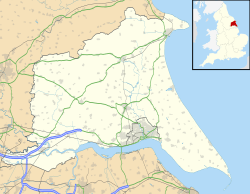Rudston Monolith facts for kids

Rudston Monolith, almost 26ft high, close to Rudston Parish Church of All Saints
|
|
| Location | Rudston |
|---|---|
| Region | East Riding of Yorkshire, England |
| Coordinates | 54°05′38″N 0°19′21″W / 54.093884°N 0.322574°W |
| Type | Standing stone (megalith) |
| History | |
| Material | Moor Grit Conglomerate |
| Periods | late Neolithic/ early Bronze Age |
| Site notes | |
| Condition | some damage |
Imagine a giant stone, taller than two giraffes stacked on top of each other! That's the Rudston Monolith, the tallest megalith (which means "big stone") in the United Kingdom. This amazing standing stone has been around for thousands of years. You can find it in the churchyard of a small village called Rudston in the East Riding of Yorkshire, England.
Contents
What is the Rudston Monolith?
The Rudston Monolith is a very tall and slender stone. It stands over 25 feet (7.6 meters) high! It is about 5.7 feet (1.75 meters) wide and nearly 3.3 feet (1 meter) thick. Experts believe the very top of the stone broke off a long time ago. If it were still pointed, it would have been even taller, around 28 feet (8.5 meters)!
How Old and How Heavy Is It?
This huge stone weighs about 40 tonnes. That's like 40 small cars! It is made of a type of rock called gritstone. Scientists think the stone was put in place during the Late Neolithic period or the Early Bronze Age. This means it's between 4,000 and 5,000 years old!
Where Did the Stone Come From?
The type of stone used for the monolith isn't found naturally in Rudston. The closest places where this gritstone is found are about 10 miles (16 kilometers) away. It's possible that ancient people moved this giant stone all that way. Another idea is that it was carried to the area by a glacier during the Ice Age.
What About the Dinosaur Footprint?
For a long time, people have talked about a possible fossilised dinosaur footprint on one side of the stone. Imagine finding a dinosaur footprint on such an old monument! However, a study done in 2015 found that this claim isn't true. It's still a cool story though!
The Monolith and the Church
There is another smaller stone, made of the same material, in the churchyard. It used to be very close to the big monolith. The Norman church that stands there today was probably built on this spot on purpose. Many churches were built on places that people already thought were special or sacred. In fact, the name "Rudston" might even come from an old English word, "Rood-stane," which means "cross-stone." This suggests that the stone was important even before the church was built, and it was later used for Christian purposes.
Other Ancient Sites Nearby
The Rudston Monolith isn't the only ancient mystery in the area. There are many other prehistoric monuments around, including four cursuses. A cursus is a very long, narrow earthwork, like a giant ancient pathway. Three of these cursus pathways seem to point right towards the Rudston Monolith. This suggests the monolith was a very important central point for the people who lived here thousands of years ago.
Past Discoveries
People have been curious about the Rudston Monolith for a long time. In the 1700s, a man named Sir William Stukeley dug around the monolith. He found that the stone went as deep underground as it was tall above ground! He also found many skulls during his dig. Later, in 1861, during some work in the churchyard, the ground level around the monolith was raised by about 5 feet (1.5 meters).


